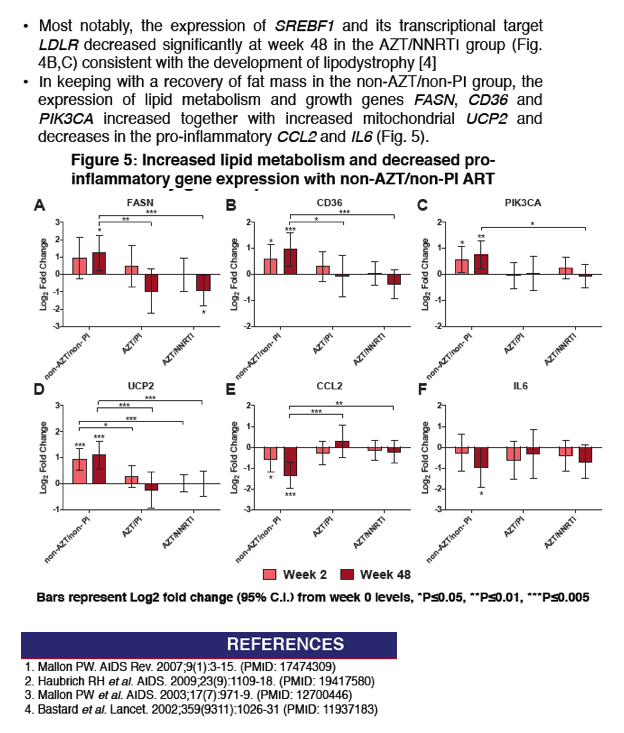 |
 |
 |
| |
ARTs & Mitochondrial toxicity......AZT/NNRTI induces greater adipose tissue mitochondrial toxicity than AZT/PI...... These findings support emerging data on NNRTIs contribution to thymidine-NRTI toxicity, suggesting additive MtTox as an underlying mechanism.
|
| |
| |
Reported by Jules Levin
CROI 2016 Feb 22-24 Boston
Maughan RT1, E Alvarez1, Kelleher A2, Cooper DA2,3, Carr A3, Mallon PWG1 on behalf of the HAMA001 Study Investigators.
1HIV Molecular Research Group, School of Medicine, University College Dublin, Ireland, 2Kirby Institute, University of New South Wales, Sydney, Australia, 3HIV Immunology and Infectious
Diseases Clinical Services Unit, St Vincent’s Hospital, Sydney, Australia.
from Jules: here are some studies looking at ART toxicities. The 2nd below reporting NNRTIs associated with frailty may be related to this study finding NNRTI may be associated with greater mitochondrial toxicity. Damage to mitochondria has been reported associated with HIV, and older NRTIs - this study and these linked to below suggest to me a link between frailty, premature & accelerated aging, cognitive impairment, essentially all or most comorbidities AND mitochob=bdrial toxicity AND draw a link of causation with HIV & these ARTs. In this first linked to study just below they review all classes of drugs including integrase inhibitors elvitegravir (and cobicistat, and dolutegravir).....
CROI: Neurotoxicity Screening of Antiretroviral Drugs With Human iPSC-Derived Neurons
CROI: Frailty is associated with NNRTI-based Initial ART and Modifiable Risks in ACTG 5322 - (02/29/16)
CROI: Belly Fat (lipodystophy) May be Caused by Metabolic Abnormalities: immune activation/inflammation/senescence

Program abstract: These data suggest greater SAT MtTox with AZT/NNRTI ART than either AZT/PI or non-AZT/non-PI. However, changes in LF did not differ significantly between AZT-treated groups. These findings support emerging data on NNRTIs contribution to thymidine-NRTI toxicity, suggesting additive MtTox as an underlying mechanism.
Use of AZT in antiretroviral therapy (ART) is associated with subcutaneous adipose tissue (SAT) and mitochondrial toxicity (MtTox). However, detailed molecular analyses of the additional contribution of protease inhibitors (PI) and non-nucleoside reverse transcriptase inhibitors (NNRTI) to this toxicity are lacking.
In a prospective cohort study, ART-naïve HIV+ subjects initiating ART containing AZT/PI, AZT/NNRTI or non-AZT/non-PI underwent assessments of clinical, demographic parameters and limb fat (LF) by DXA at wks 0, 12, 24 and 48. Mitochondrial DNA (mtDNA) and expression of 55 key insulin signalling, lipid metabolism and mitochondrial function genes were measured by qPCR in fasting SAT biopsies from wks 0, 2 and 48. Associations between treatment groups and parameter changes were analysed by adjusted longitudinal marginal models, gene expression by LIMMA in R, with data presented as model parameter estimates (PE [95% CI]).
23 subjects were recruited, median [IQR] age 39 [34, 48] yrs, 91% Caucasian, 87% male, CD4+ count 132 [58, 228] cells/mm3, log HIVRNA 4.97 [4.51, 5.57] cps/ml. Over 48 weeks, LF increased as expected with non-AZT/non-PI ART (+30.5 [+11.9, +49.1] g/wk) with significantly lower LF gains in the AZT/PI and AZT/NNRTI groups (-15.7 [-45.7, +14.2], P=0.005 and +4 [-29.3, +21.3] g/wk, P=0.012 respectively). Initiation of ART led to decreased expression of inflammatory genes in groups overall, including CCL2 (P=0.017) and IL6 (P=0.017, P=0.033). The largest mtDNA decreases occurred with AZT/NNRTI ART (-10.2 [-20, -0.6] cps/cell/wk), being significantly greater than both AZT/PI and non-AZT/non-PI ART groups (P.E. +3.2 [-8, +14.3], P=0.001 and +2.2 [-5.2, +9.5], P=0.015 respectively, fig.1). Consistent with MtTox, this group also had upregulated expression of the mitochondrial biogenesis gene TFAM (P=0.012) and decreases in key metabolic genes LEP and INSR at week 48 (P=0.013 and P=0.049 respectively), none of which were observed in the other two groups. In fact expression of several key adipocyte genes increased at week 48; PPARG and FABP4 with AZT/PI (P=0.021 and P=0.001) and Adiponectin with non-AZT/non-PI (P=0.006).







|
| |
|
 |
 |
|
|